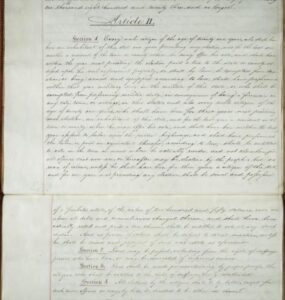The Ballot Box in New York State
Since 1777 local, state and national laws have effected who can vote in New York State. At one time or another wealth, ethnicity, gender, age, and even literacy determined whether a person was eligible to vote. Below is a brief timeline of voting history in New York State.
1777- Under the state’s first constitution, to be eligible to vote one had to be male, white, a property owner, 21 years old, and a resident of a New York county for six months before the election.
1821 – The state’s second constitution is adopted and among the changes are voting qualifications. All men over 21 were eligible to vote if they met certain requirements. For white men this meant – one year resident of the state prior to the election, resident of the town or county where they would vote for six months, and either owned property, performed militia duty, served as a fireman in any city, town, or village in the state or fulfilled the public labor requirement (three year resident of the state, one year resident of the town or county where he will vote and performed labor on a public highway). For African American men this meant three year resident of the state prior to the election, one year resident of the town or county where they would vote and owner of property valued at $250 (today that would roughly be $5,600). The property requirement effectively disenfranchised nearly all African American men in the state.
1868 – The ratification of the 14th Amendment grants citizenship to all people born or naturalized in the United States.
1870 – Under the 15th Amendment the right to vote is guaranteed “regardless of race, color, or previous condition of servitude.” Into the 20th Century, however, poll taxes, literacy tests and other methods of voter suppression were instituted across the country to disenfranchise African Americans and immigrants.
1871 – Geneva’s village charter grants female property owners the right to vote on tax issues.
1880 – Women in New York State are given the right to vote for school board members and serve on school boards.
1917 – By a state wide referendum New York becomes the first state east of the Mississippi River to grant women full suffrage. Yet the referendum failed in every single upstate county and the only town to pass it in Ontario County was Seneca.
1921 –An amendment to the state constitution passes by general election requiring that all new voters prove that they can read and write English. Amended several times by the state legislature, under the law new voters had two options to prove their literacy. One method was to present an 8th grade (or an equivalent) diploma or certificate. If someone did not have a diploma or certificate, they had to take a written and oral test conducted by the Board of Regents at a public school.
1965 – Congress passes the Voting Rights Act of 1965. Primarily aimed at voter suppression across the South, the Voting Rights Act ensures that no person is denied the right to vote on account of race or color. The Voting Rights Act has been amended several times to expand protections for voters.
1971 – The 26th Amendment lowers the voting age from 21 to 18.
Today to register to vote in New York you must
- Be a United States citizen
- Be 18 years old
- Be a resident of New York State and of the county, city or village where you will be voting for at least 30 days before the election.
- Not be in prison or on parole for a felony conviction (unless the parolee has been pardoned or rights of citizenship have been restored)
- Not be adjudged mentally incompetent by a court
- Not claim the right to vote elsewhere.


